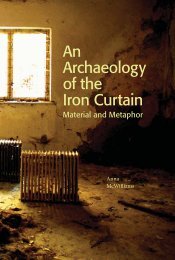Create successful ePaper yourself
Turn your PDF publications into a flip-book with our unique Google optimized e-Paper software.
12<br />
AN IMPRESSIVE AND FINE MUGHAL TENT<br />
PANEL (QANAT)<br />
RAJASTHAN, MUGHAL <strong>INDIA</strong>, 18TH CENTURY<br />
Painted, block-printed and mordant-dyed cotton,<br />
decorated with a fowering three rising to a mihrab<br />
arch, with foral spandrels and borders<br />
15ft. 9in x 3ft. (480 x 91cm.)<br />
£60,000-80,000 $86,000-110,000<br />
€75,000-100,000<br />
This tent panel, or qanat, is part of a well-known series<br />
of chintzes, examples of which are held by important<br />
museums worldwide. The largest, which forms the<br />
interior of a tent is to be found in the Tapi Collection<br />
in India (Ruth Barnes, Steven Cohen, Rosemary Crill,<br />
Trade, Temple & Court, Indian Textiles from the Tapi<br />
Collection, Mumbai, 2002, cat.62, pp.160-161). That<br />
example is composed of six vertical panels, two of<br />
which are border panels identical to the present<br />
piece and at 450cm long are the longest of all. In the<br />
discussion of this panel, it is noted that they could<br />
only have been made for the interior decoration of a<br />
spectacular, royal tent. Another panel from the series<br />
sold at Christie’s South Kensington, 13 October 2000,<br />
lot 72 (illustrated on back cover). A further related<br />
example from a private collection was exhibited in<br />
the Victoria & Albert Museum, 21 April-22 August<br />
1981, illustrated in the exhibition catalogue, ‘The<br />
Indian Heritage, Court life and Arts under Moghal<br />
Rule’, no. 212, p85. AEDTA ‘Le Motif Floral dans<br />
les Tissus Moghuls’ - plate 3 shows a qanat from<br />
what appears to be the same set, of smaller size.<br />
Another panel is in Musée Guimet, Krishna Riboud<br />
Collection (Mattiebelle Gittinger, Master Dyers to<br />
the World, Washington, 1982, cat.72, p.82). See also<br />
a foorspread cotton decorated with poppies in red<br />
on beige colour background in the Calico Museum,<br />
catalogued as Rajasthan or Khandesh, 17th or 18th<br />
century (Treasures of Indian Textiles, Calico Museum,<br />
Ahmedabad, 1980, fg.7, front and back cover).<br />
The Mughal Imperial court was a peripatetic court<br />
which travelled regularly. The Court’s audience rooms,<br />
workshops and private apartments were all to be<br />
found under canvas, waterproof on the outside and<br />
hung with rich fabrics, velvets and chintzes of high<br />
quality inside. The tents would refect the royal wealth<br />
and the majesty of the imperial presence. Designs<br />
of this strength and scale were certainly meant to<br />
impress courtiers visiting the emperor.<br />
13<br />
PROPERTY FROM THE COLLECTION <strong>OF</strong> JOHN ROBERT<br />
ALDERMAN AND THE LATE DR. MARK ZEBROWSKI<br />
13<br />
A FINELY CARVED MUGHAL WHITE MARBLE<br />
PANEL<br />
NORTH <strong>INDIA</strong>, 17TH CENTURY OR LATER<br />
Of rectangular form, the carved decoration consisting<br />
of an elegant foral spray with butterfies<br />
31 x 19in. (78.8 x 48.4cm.)<br />
£8,000-12,000 $12,000-17,000<br />
€10,000-15,000<br />
PROVENANCE:<br />
Christie’s South Kensington, 8 August 1991, lot 5<br />
12<br />
10




